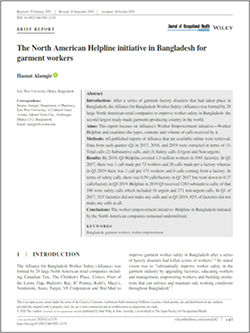#0098 The North American Helpline initiative in Bangladesh for garment workers

Actions Speak Louder than Words: Report on “Alliance” Initiative to Improve Garment Factories in Bangladesh
Bangladesh is the second largest readymade garment producer in the world. The big buyers of the factories in the country are North American giant retailers. In the recent past, these factories have had some disasters that have resulted in the loss of worker life. Therefore, to improve the safety of workers in the garment industry, the Alliance for Bangladesh Worker Safety (Alliance) was formed by 29 North American retail companies, with the aim to educate and empower workers and enforce safe working conditions.
As a part of the Alliance Worker Empowerment initiative, a 24-hour Worker Helpline called “Amader Kotha”, or “Our Voice”, was initiated. It aimed to provide workers a channel to share concerns on issues such as workplace abuse and wage compensation disputes and report any tragic incident at the factories. In my report, I analyzed the numbers and nature of the calls received on this helpline.
After studying quarterly data on calls for three years—2017 to 2019—I found that the helpline was substantially underutilized. Although by 2019 the helpline covered 1.5 million workers across 1091 factories, the number of calls declined across the study period. By the third quarter of 2019, there was 1 call per 171 workers. Moreover, among the calls received, most were non-urgent calls.
This decline in the number of calls could be either due to improvement in the factories or loss of interest and motivation among workers for the helpline. The second reason seems more probable because the initiative was not well-promoted among the workers. It was piggybacked with the fire safety training program, which could have de-emphasized the helpline. Additionally, the factory owners have a role to play as their encouragement is necessary for workers to report incidents on the helpline. Ultimately, if the workers do not get enough motivation and incentive to report their grievances, then the helpline would remain a “cosmetic” effort, superficially working for the benefit of the factory workers.
This also shows that the efforts of the North American companies have been inadequate in extracting the maximum benefit from the helpline. Such helplines have the potential to act as means of understanding the workers, their needs, and the safety issues at the factories, which could further help in devising policies and programs for the garment industry.

Link to the original journal article:
https://onlinelibrary.wiley.com/doi/full/10.1002/1348-9585.12178
Title of the paper:
The North American Helpline initiative in Bangladesh for garment workers
Authors:
Hasnat Alamgir




